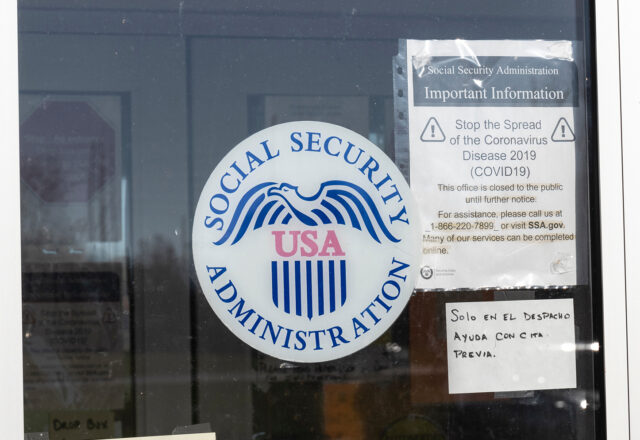
Crisis for Renters Threatens to Get Worse
Many unemployed and underemployed workers have run out of options for paying the rent. The National Low Income Housing Coalition, the Aspen Institute, and other organizations estimate that up to 40 million renters risk being evicted this winter. Congress is currently negotiating a new COVID-19 relief package but it’s not yet known whether it will extend a CDC moratorium on evictions or go beyond the Cares Act last spring and provide rental assistance to help renters and, by extension, their landlords.
Squared Away spoke with Sarah Saadian, vice president of public policy for the National Low Income Housing Coalition, about what she describes as an impending calamity.
Q: How bad is the current situation?
Saadian: It’s really hard to get data on how many people have been evicted because there isn’t a national database – only state data. But we know that nearly one in five renters are behind on their rent, and they’re disproportionately Black and brown renters. When the CDC moratorium on evictions expires Dec. 31, renters are going to owe somewhere between $25 billion and $70 billion. That’s a huge amount of back rent that renters realistically can’t afford to pay off. So what we’re likely to see is a huge increase in evictions and, in the worse cases, homelessness unless Congress extends the moratorium and provides really robust resources for emergency rental assistance.
Q: What do you expect if the moratorium isn’t extended beyond Dec. 31?
It would be a calamity. Because of the loopholes in the CDC moratorium and because of the sheer amount of rent renters owe, if there’s any gap between when the moratorium expires and the Biden administration takes action – if they do – you’re going to see potentially millions of people lose their homes in the dead of winter when we’re dealing with a resurgence of COVID. It’s an emergency on top of an emergency.
Q: A UCLA study said that 44 states had moratoriums but that 27 have lifted them and that the resulting evictions have resulted in more than 10,000 deaths. Make the connection between housing and health.
When low-income people are evicted from their homes, they don’t have a lot of good options. They either are doubling or tripling up with other families, or they go into homeless shelters. In either case, it’s more difficult to social distance, and it’s easier for the virus to spread. If Congress doesn’t take action, it harms all of us. Not only does it mean more of us dying from COVID but it puts more strain on our health care system.
Q: This is a complicated issue, because small landlords have to pay their mortgages and can’t necessarily afford to cover tenants’ rents. What is your position on that?
The best solution for both renters and landlords is emergency rental assistance because that eliminates the back rent renters owe and makes up the lost income landlords need to operate their property. It is not every day that landlords and renters can agree. A lot of landlords don’t like the moratorium but it’s absolutely essential to have an extension of the CDC moratorium at least until state and local governments can distribute rental money to people in need. Even if Congress provides emergency rental assistance, but doesn’t extend the CDC moratorium, then millions of people will still lose their homes.
Q: You mentioned minorities are particularly affected by evictions. How about particular states or income groups? Rural vs urban renters?
Again, we don’t have a ton of real-time data, and it’s hard to get more granular geography-wise. But we do know that people who have the lowest incomes are the people who are most at risk, because those were the households already struggling to pay their rent even before the pandemic. Any financial shock can push them over the edge, and for the very lowest-income people, this pandemic is that financial crisis. Twenty-six percent of Black families are behind on their rent, compared with 16 percent of all renters and 18 percent of Latinos. It’s not surprising because we know that Black households are more likely to be struggling to pay their rent, are most harmed by COVID infections, and most likely to be in essential jobs.
Q: How common is homelessness in the wake of an eviction?
It’s hard to predict. Do they have family ties and someone to fall back on? But even if a small proportion of people become homeless, it can have an enormous impact on the spread of COVID. We put together a study that also showed that when people become homeless, there’s an enormous cost to our emergency healthcare system, our policing system, our foster care system. So there are all these other government costs that would increase. We estimate up to $129 billion in costs if we do nothing. It’s a lot more effective to spend $100 billion to provide people with emergency rental assistance to keep them housed.
Q: The CDC’s current eviction moratorium says: “A landlord … shall not evict any covered person from any residential property in any jurisdiction” through Dec. 31, when the moratorium expires. How effective has this been?
There are definitely loopholes in it, and landlords are exploiting them to kick people out of their homes. But the moratorium is still protecting millions of people, so we’re encouraging the CDC and Congress to extend it and also close those loopholes. For example, the original CDC order said landlords can’t take any action to evict people from their homes. But the CDC backed off that by saying that landlords can file for eviction and take all the steps they want, as long as the physical eviction doesn’t happen before the end of the moratorium. That means landlords file now and use it to harass tenants to leave early. And there’s no enforcement of the CDC protections, so there’s really no recourse for renters – especially renters who cannot afford an attorney to bring a suit. Landlords violate the order without any consequences.
Q: Eviction activity in many states – Texas, California, Massachusetts, Nevada, South Carolina, and Washington – is either high or rising, despite the moratorium. Tell me about that.
We’re seeing landlords refuse to accept the CDC form renters provide to them to be protected. We see landlords filing for evictions before renters even know the moratorium is in place. It’s really disheartening that these landlords would move forward with evictions at a time we know it puts lives at risk. We should all be pushing for as much emergency rental assistance as possible to keep people in their homes and make landlords whole.
Q: Do you have any details about what’s being considered for renters and landlords in the current relief talks in Congress?
There is a bipartisan group of senators working on a COVID relief package that includes $25 billion in emergency rental assistance. They’ve also agreed to a short-term moratorium. But a lot of the details are unknown, so we need to keep pushing them to make sure this assistance is targeted to households most at risk of losing their homes this winter.
Q: Was the current moratorium accompanied by rental assistance?
No, it was just a moratorium.
Read our blog posts in our ongoing coverage of COVID-19.
Squared Away writer Kim Blanton invites you to follow us on Twitter @SquaredAwayBC. To stay current on our blog, please join our free email list. You’ll receive just one email each week – with links to the two new posts for that week – when you sign up here. This blog is supported by the Center for Retirement Research at Boston College.
Comments are closed.







There are good public health arguments for avoiding evictions. But the cost should not fall on landlords, who are running a business, not a social service. And the moratorium has the unintended consequence of making landlords even more reluctant to rent to people who are at risk of not paying their rent.